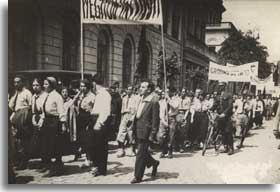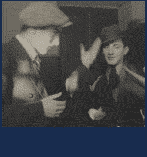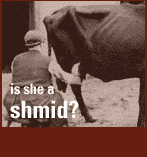

B. Jewish Nationalism
A number of Jewish political organizations had Jewish nationalist agendas. Many also had cultural nationalist interests that simply strove for Jewish cultural autonomy. Others, however, were specifically interested in political autonomy. The largest and most important Jewish nationalist organization, the Zionist movement, sought Jewish political and cultural autonomy in their own nation-state. The majority of Zionists envisioned establishing this independent nation in the historical land of Israel, which at that time was Palestine. The Zionist mainstream organization had several off shoots including the religious branch of the party, Mizrachi  , and the Revisionist branches which included the right wing youth movement Betar
, and the Revisionist branches which included the right wing youth movement Betar  .
.
ZIONISM
Although the Zionist movement was founded by a Western, assimilated Jew, Theodore Herzl  , as a secular nationalist movement calling for a Jewish state, the majority of early Zionists were from Eastern Europe and came from a religious perspective. Jewish nationalist groups seeking Jewish settlement in the Land of Israel had existed in Eastern Europe, prior to Herzl. The earliest movement for a "return to Zion" had a religious outlook and was led by Rabbi Zvi Hirsch Kalischer. However, with the onset of violent pogroms against Jews in the Russian Empire beginning in 1881, Zionist groups began to develop in other places. The most important, the Russian based movement, Hibbat Zion (Love of Zion), created the Bilu movement, which established settlements in Palestine. However, it was Theodore Herzl, who through the publication of his pamphlet, The Jewish State: An Attempt at a Modern Solution to the Jewish Question, and the formation of the first Zionist Congress
, as a secular nationalist movement calling for a Jewish state, the majority of early Zionists were from Eastern Europe and came from a religious perspective. Jewish nationalist groups seeking Jewish settlement in the Land of Israel had existed in Eastern Europe, prior to Herzl. The earliest movement for a "return to Zion" had a religious outlook and was led by Rabbi Zvi Hirsch Kalischer. However, with the onset of violent pogroms against Jews in the Russian Empire beginning in 1881, Zionist groups began to develop in other places. The most important, the Russian based movement, Hibbat Zion (Love of Zion), created the Bilu movement, which established settlements in Palestine. However, it was Theodore Herzl, who through the publication of his pamphlet, The Jewish State: An Attempt at a Modern Solution to the Jewish Question, and the formation of the first Zionist Congress  in 1897, provided international organization and recognition for the Zionist movement.
in 1897, provided international organization and recognition for the Zionist movement.
The Eastern European Zionists played an important role in more clearly defining the goals of the early Zionist movement. The Zionists from Eastern Europe demanded that the future Jewish nation be located in the historic Jewish homeland - Palestine - in opposition to Herzl's proposal of Uganda as a possible location for establishing a Jewish state. The early Eastern European Zionists also worked to gain recognition of Jews as a national minority in their respective territories, the Russian and Austro-Hungarian Empires.
Although Zionism began as a secular movement, in 1902, Mizrachi  , an Orthodox branch of the movement, was formed. This branch was important in attracting religious Jews to the Zionist movement. In addition to this religious division of Zionism, there was the more militant non-Socialist branch, the Zionist Revisionists
, an Orthodox branch of the movement, was formed. This branch was important in attracting religious Jews to the Zionist movement. In addition to this religious division of Zionism, there was the more militant non-Socialist branch, the Zionist Revisionists  with their youth organization Betar. The Po'alei Zion
with their youth organization Betar. The Po'alei Zion  , founded in 1901 by Nachman Syrkin (1868 - 1924), combined Zionist ideals with socialist ones, suggesting that the Jewish state must be a Socialist state from its inception. This movement assumed an international character in 1907 with the foundation of the World Union of Po'alei Zion.
, founded in 1901 by Nachman Syrkin (1868 - 1924), combined Zionist ideals with socialist ones, suggesting that the Jewish state must be a Socialist state from its inception. This movement assumed an international character in 1907 with the foundation of the World Union of Po'alei Zion.
However, the movement was not unified. In 1909 for example, the Russian branch of Po'alei Zion broke away from the World Zionist Organization while the Austro-Hungarian branch of the organization maintained ties with the WZO. The movement further fractured when in 1920, split into the "Left Po'alei Zion" remaining staunchly Socialist and tied to the socialist party, and the "Right Po'alei Zion" which refused participation in the Third International  .
.


Po'alei Zion, sponsored cultural activities, maintained newspapers, and was involved in local and (sometimes) national politics. In Poland, for example, it joined forces with the Bund to try to elect members to the Polish parliament. David Ben-Gurion  , first prime minister of the State of Israel, was one of the most famous members of Po'alei Zion.
, first prime minister of the State of Israel, was one of the most famous members of Po'alei Zion.
As with other political groups, this movement had numerous youth groups associated with it. Youth movements added an extremely important element to the vitality of the Zionist movement. All youth groups were also involved in the hakhshara movement. Hakhsharot groups attended agricultural training schools, which taught their youth how to farm the land in preparation for emigration to Palestine. In fact, a graduate certificate from a recognized hakhshara ultimately became an important part of applying for a visa to go to Palestine. These activities and training were important not only for the preparation provided for leading another type of life in Palestine/Israel, but they additionally provided Jewish Zionist youth with social activities and experiences which unified them in novel ways.












